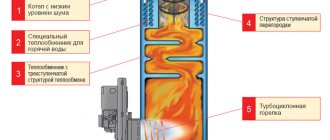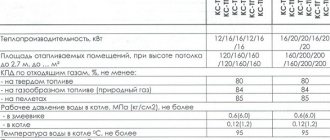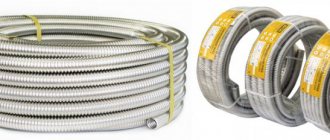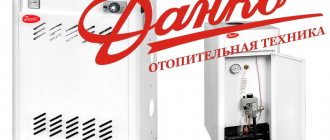What is PLEN heating
This technology is based on increasing the temperature of objects under the influence of radiation in the infrared range. The required result is achieved by passing electric current through a resistive element.
Design
Using this figure, you can study in detail a typical element of the PLEN heating system:
- To connect the power supply, special conductors (1) are installed, which are connected to special contact pads (3).
- The resistive strip (4) is laid in a “snake” pattern in strict accordance with engineering calculations. The uniformity of radiation is ensured and excessive heating is prevented.
- A thin aluminum layer (5) additionally smoothes the directional pattern of electromagnetic waves in the infrared range of the spectrum.
- The listed components are enclosed in a durable polymer shell (6). It does not prevent the spread of useful radiation, but reliably protects against the penetration of moisture and mechanical influences.
- The figure shows a holographic mark (2), which the manufacturer installs to identify potential buyers of quality products.
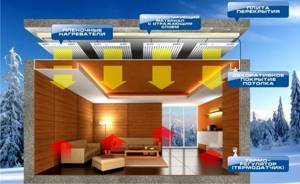
Installation diagram and principle of operation
Infrared heating PLEN (film emitter) is installed inside the ceiling structure. It is connected to the power supply via a thermostat. Radiation in this range passes through the decorative coating, heats the floor, furniture, and other objects in the corresponding impact zone. When the desired temperature level is reached, the system turns off to save energy. Further, the thermal mode set by the user is maintained automatically.
Infrared Heating Basics
Long waves are the most comfortable for people. Since the range of infrared radiation itself is quite large, scientists divided it into three subranges:
- Short - it is adjacent to the visible part of the world.
- Average.
- Long.
The hottest objects emit shorter wavelengths. The warmer the object, the shorter the wave.
PLEN heating is an alternative to the outdoor heating system used by nature.
The PLEN system, mounted on the ceiling, allows you to obtain thermal comfort in the same way that the Sun gives it to all living things. Long-wave radiant energy emitted by heating elements heats objects, floors, cars, which, in turn, accumulate it and then release it into the environment. At the same time, air humidity remains natural.
That is, the meaning of what has been said comes down to the fact that in order for the room to become warm, it is not at all necessary to heat the air in it.
Advantages and disadvantages of the PLEN heating system
The following list shows the advantages, features and some important parameters of quality systems in this category:
- The conversion of electricity into heat is carried out efficiently, without unnecessary losses. Efficiency reaches 90-95%, which is 15-20% better than standard oil heaters.
- The temperature of the external surfaces of PLEN heating films does not exceed +50°C. This means that no additional measures are required to comply with the most stringent fire safety regulations.
- It is acceptable to place the PLEN film heater close to wooden and plastic parts. This simplifies installation and selection of suitable structural elements and finishing materials.
- At this temperature, mechanical particles contained in the room atmosphere do not burn.
- Convection flows are minimal for any placement of the PLEN heating system. This prevents the movement of dust, contamination of premises, and the occurrence of allergic reactions.
- The small thickness of the film means economical use of free space.
- IR emitters of this type are hidden behind decorative panels and functional coatings. They do not have any impact on the aesthetics of the interior.
- To connect such a heating system, you do not need proximity to a main gas pipeline.
- Laying cable routes is cheaper than installing pipes. Working operations are simplified by the low weight and high strength of film structures.
- Ceiling infrared heating performs its functions without chimneys, circulation pumps, boilers and boilers.
- Film emitters provide fast heating and operate completely silently.
- Their minimal inertia, together with the control principles, are well suited for inclusion in modern control complexes of the “smart home” category.
- With appropriate equipment, it is not difficult to maintain the temperature in individual rooms with high accuracy (±1-1.5°C).
- Good protection from external influences combined with gentle temperature conditions ensure a long service life. Modern models retain good consumer characteristics for 50 years or more.
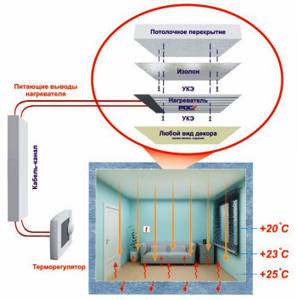
“Pros” of PLEN: simple installation, inexpensive components, rational distribution of air temperature
As reviews indicate, a film heater really has many advantages. However, for an objective analysis it is necessary to consider the “cons” that are mentioned by the owners and some specialists in the field.
The heating area is limited by the direction of radiation. Outside the corresponding zones, the air temperature is noticeably lower. To maintain uniform temperature in the room, it is necessary to cover large areas with film emitters.
Despite the high efficiency and relatively low consumption per 1 sq. m. PLEN will have to take into account significant operating costs. The cost of heating using electricity is higher these days compared to gas. To connect, you will need a power source of appropriate power.

You can save additional money if you install a simple “potbelly stove” and engage in illegal logging
A serious analysis will help more accurately estimate the real costs when comparing PLEN with alternative heating systems. You can do it yourself, taking into account individual needs and operating conditions. Please pay attention to the following nuances:
- To use liquid heating systems, you need to purchase and install radiators, pipes, shut-off devices, a boiler, and other components.
- When using such equipment, it is necessary to provide reliable protection against freezing and prevent the formation of scale.
- To store relatively inexpensive solid fuel, you will need a warehouse. Handling it is accompanied by additional labor costs.
For your information! Some comments cite the following “disadvantage”: mandatory insulation of premises in accordance with the standards of current SNiP. But in fact, such measures are necessary when equipping any heating system. They increase the energy efficiency of the facility.
Calculation of PLEN energy consumption using the example of a house of 100 square meters. m

Our homes lose the most heat through windows, doors, floors and roofs. By choosing the best building and finishing materials, you can save a lot on heating costs.
We have already calculated how much film is needed. But will heating really “eat up” so much electricity? In fact, the costs will be small. Firstly, PLEN heating does not work around the clock - it turns on and off, obeying the thermostat. And secondly, infrared heating is economical. Therefore, the costs will not be very high.
If the house has good thermal insulation, then PLEN will work for about 10-15 minutes per hour . Based on the average cost of 1 kW of energy at 4 rubles, the cost of round-the-clock operation for a house of 100 sq. m would be 960 rubles per day. If the heating runs for 10 minutes, the daily consumption will be only 160 rubles. This will cost approximately 4,800 rubles per month.
By taking care to eliminate heat losses, you can ensure a significant reduction in space heating costs.
Scope of application of the PLEN heating system
The use of high-quality infrared emitters is harmless to human health, pets, and plants. It does not damage decorative coatings and functional parts of building structures. The absence of significant restrictions predetermines a wide scope of application.
PLEN heating is used to equip apartments and cottages, offices and kindergartens, public and industrial facilities. When installed in warehouses and other large premises, the emitters can be mounted only above workstations, in aisles. Rational placement of equipment will help create comfortable conditions without unnecessary installation and operating costs.
Taking into account good protection from adverse external influences, it is permissible to use PLEN heating in a wide range of humidity and temperatures. The exact boundaries are set in the manufacturer's accompanying documentation.
Important! When developing a system, official recommendations on the operating parameters of thermostats and other components should be taken into account. The required degree of security is checked taking into account IP classification standards.

The specially designed switch performs its functions reliably even in open spaces
PLEN for private houses
Infrared heaters are suitable not only for new buildings, but also for the reconstruction of existing ones.
By choosing PLEN heating, you will be able to save significantly already at the design stage. There is no need to build a special boiler room or allocate one of the rooms of the house for it. You also don’t have to think through a fuel storage scheme, be it coal, firewood or diesel fuel.
There will never be a smell of burnt coal or diesel fuel in the house. In addition, the appearance of the house will not be spoiled by radiators and pipes protruding from the walls, which are inherent in traditional heating. And most importantly, IR heaters will remove dampness in the shortest possible time, maintaining a comfortable temperature in all individual rooms.
Main technical characteristics of PLEN heating
When choosing emissive films, pay attention to the following parameters:
- Power supply. As a rule, these products are designed for connection to a standard single-phase 220 V network. Some manufacturers indicate the permissible voltage deviation range (in %), which ensures that the nominal technical characteristics are maintained.
- The maximum current consumption will help you select the correct residual current devices for individual electrical circuits.
- Radiation flux density is indicated in W per 1 square meter. This value determines the efficiency of the device and allows you to correctly assess the capabilities of the heating system to heat a particular room.
- The power of one element is useful for calculating total consumption.
- The temperature on the surfaces of modern models does not exceed +45°C.
- Dimensions are needed to calculate the required number of PLEN heaters.
- The minimum thickness of a typical PLEN (approximately 0.3 mm) can be neglected when developing a project.
Some manufacturers offer thermostats and GSM units as a set or separately for creating a heating system. The parameters of these products are checked taking into account individual needs. If necessary, purchase analogues of other brands with better performance.
System components
If you decide to choose PLEN as the main heating system, then you need to take into account the level of air exchange: more than 80% of the area of the room that will be heated must be covered with film. These are walls, floor, ceiling. When applying isolon to the ceiling, you need to make overlaps on the walls of up to 3 cm. This will prevent heat leakage from your room.
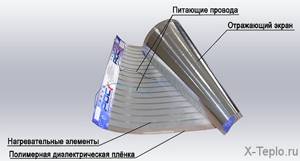
Before connecting the PLEN, you need to find out its technical characteristics. They include the efficiency level, protection class, voltage used, current consumed, electrical power, radiation wave. It is advisable to read user reviews.
Options for production forms of PLEN heaters

Assortment of domestic manufacturer of film IR emitters
Standard products are produced with a width of approximately 0.5 m, a length from 1 to 5 m. It is not difficult to choose a set that exactly matches the size and configuration of a particular room. Please note the modification marked with an arrow. This is an autonomous film heater that can be mounted on the wall in any desired place.

In this design, PLEN becomes an element of interior decorative design
Recommendations when choosing a system
For ease of installation, films are available in different lengths and widths. The length varies from 1 to 5 meters , and the width is 35-65 cm .
The films are installed on approximately 80% of the ceiling surface. The area of the occupied floor depends on the amount of furniture. It is not advisable to install a heating system under upholstered and cabinet furniture, since natural heat exchange with the air will not occur.
also affect the efficiency of film heaters . If your home is located in a windy climate, you should choose a more powerful heating system, since heat loss will be significant in this case.
Important! Before installing the PLEN system, take care of the thermal insulation of the room. All surfaces should be insulated - floor, ceiling, walls, insulate windows and doors, and in a private house - the roof and basement. Otherwise, the operation of the PLEN will be associated with high energy costs.
The influence of infrared radiation from PLEN heating on human health
High-quality devices of this type generate waves with a length of more than 9 microns. This radiation is completely safe for humans. It is not able to penetrate deep into the skin. It cannot be used for tanning. Relevant certifications confirm the possibility of using PLEN heating in medical institutions, schools, universities, kindergartens, and residential buildings.
For your information! With high-quality insulation of the room, the film emitter operates for 4-10 minutes per hour (after the air temperature rises to the operating value).
Additional installation recommendations
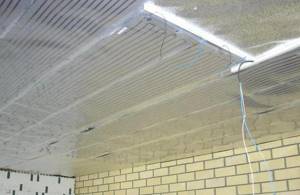
The manufacturer does not provide recommendations regarding the quantity of fasteners. The main condition during installation is to prevent the film from sagging. Up to nine fastening points can be used per square meter of canvas. This data will allow you to calculate consumables.
Fastening must be done within the designated mounting fields. It is strictly prohibited to make holes in other areas of the canvas. If you plan to install a decorative covering on top, for example, a suspended ceiling, then the distance from the film to the covering plane should be 150 mm maximum. The minimum value is 10 mm. An air gap is mandatory in any case.
Types of PLEN systems according to the method of placing heaters
The typical installation method, in the ceiling, is optional. Subject to the general rules, other options may be used.
Ceiling systems

In the simplest version, you don’t have to install a decorative coating
Please note that a reflective surface is installed under the emitter (foil insulating material, another layer of a similar purpose). This addition directs the radiation towards the working side.

Guides facilitate neat installation. These ribs will later be useful for attaching plasterboard slabs and other types of ceiling finishing

Securing heaters at an angle to the horizontal
Floor systems

Creating comfortable temperature conditions in the bathroom
PLEN heating is well suited for equipping such premises due to its reliable protection against humidity. Durable film can be installed under ceramic tiles, parquet, and other types of floor coverings. As noted in the reviews, the energy consumption when operating a heated film floor is not too high. However, actual indicators depend on the characteristics of a particular project.
For your information! When implementing such projects, do not forget about the different thermal conductivities of materials. A layer of concrete, ceramics, natural stone - minimal losses. Parquet on thick plywood creates a high-quality insulation layer that reduces the efficiency of heaters.
Related article:
Which warm floor under tiles is better? From this publication you will learn about the nuances of using TP under tiles, the subtleties of installation, the pros and cons of different types of floors.
Tips for choosing
In order not to be disappointed in the IR heater, you should treat the purchase of this device responsibly and calculate everything in advance. Please evaluate the following criteria carefully.
- Possibility of heating using other, cheaper options. For example, it is not entirely reasonable to install an electric heater where there is gas. The latter option is still more economical. If gas is not available, then PLEN will be a good option.
- How much time do you plan to spend indoors? If you are considering the option of heating using a film heater in a country house where people do not live all year round, then you can make a choice in favor of decorative panels or IR paintings. Installing a full-fledged ceiling or floor system in such a room is impractical due to its high cost, as well as labor-intensive installation.
- PLEN shows itself most fully in concrete and brick houses, but in buildings made of other materials alternative options can compete with them.
- Before purchasing, you must check all certificates for the heaters you purchase. Unfortunately, not all sellers sell goods of adequate quality. Therefore, it makes sense to purchase products only from proven and reliable companies.

Guided by these tips, you can choose the best option for PLEN and save not only money, but also installation time.
Nuances of installing the PLEN heating system
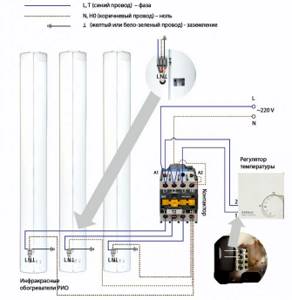
Electrical diagram
Shown here is a method for connecting three film-type IR emitters to the power supply. For the reflective layer, you can use “isolon”, “alufom”, or other foil material. The wiring is installed in grooves (cable channels of suitable size). Automatic circuit breakers corresponding to the loads are installed in the electrical panel. The thermostat mounting level is chosen to be convenient for the user.
For your information! For ceiling heights of more than 5 m, a radiation power density of more than 230 W/m2 is required. Films with such parameters are not produced so as not to violate safety regulations. Up to 2.8-3.2 m, 120-130 W/m2 is quite sufficient.
For efficient heating, taking into account domestic climatic conditions, it is recommended to cover at least 65% of the ceiling/floor area with film radiators. If the average annual temperature is below -5°C, increase to 75-85%.
Nuances of the installation process
It should be noted right away that the PLEN heating system is installed on foil insulation, which will not only create a thermal insulation layer, but also reflect emitted waves towards the room using foil. Therefore, the surface on which the heating film will be mounted must be covered, for example, with isolon.
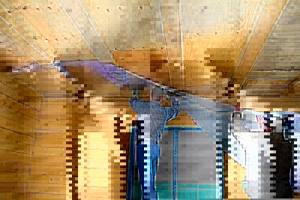
Izolon must be placed under PLEN
Now, regarding the mounting of the heater itself. Everything will depend on what material it will be attached to.
- If it is wood, then the best option is metal staples and a stapler. In this case, you can use nails or wood screws.
- If it is concrete, then you will have to drill holes in it, insert plastic dowels into them, and screw screws into them through the film.
As for the principle of laying the film, first of all you need to decide in which direction the connection to the current supply will be located. The shorter the distance between the connection points, the less cables you will have to use for wiring. And this is savings.
Depending on the chosen model and size of the heater, its coverage area is determined. This indicator varies between 50÷100%, but 80% is considered optimal.
Connection nuances
Depending on which voltage devices were selected, their own circuits are used:
- If films with a voltage of 220 V are selected, then they are connected to each other only in parallel.
- If 110 V devices are used with a connection to a 220 V network, then they are connected to each other in pairs. The latter are connected to each other in parallel.
- The same is with PLEN heaters with a voltage of 73 V. They are connected to each other in series, 3 pieces at a time.
Heating system PLEN: reviews from real owners
BabaFros9, Moscow. Used for infrared heating at home. Review: Advantages: This system is one of the best for saving energy, and therefore saving your money. It does not collect dust, and this is also a big plus, since at high heating temperatures of heating devices, dust begins to release harmful substances into the room. Climate control is a useful thing; you can choose the temperature you want in each room, at which you will be comfortable. Withstands voltage surges. Disadvantages: Expensive to install. More details on Otzovik:
filipok49, Nevyansk. Installed an infrared warm ceiling. Review: Advantages: Practical, economical. PLEN is fireproof, energy efficient, has the highest protection class - lp67, and is not afraid of defrosting, voltage surges, or water leaks. Disadvantages: few people know about it, little advertising. More details on Otzovik:
Installation options for film heaters
In theory, film-type IR heaters can be installed on any flat surface. But, in practice, they are usually mounted on the floor or ceiling. You can also install it on the wall, but this will be the least effective option, since the heated air flows will rise straight up, significantly limiting the actions of the heater.
Therefore, we will consider in more detail all the nuances of more effective ways to use PLEM floor and ceiling placement.
Floor placement PLEN
The film structure is attached directly under any floor covering. After connecting the heater, it quickly warms up and begins to emit infrared waves. They rise upward to the floor plane and are absorbed by the floor covering, which heats up and, in turn, transfers heat to the air. The heated streams move to the top, and colder ones arrive to replace them.
As a result, the room heats up quite quickly. Despite the difference in the location of the film heaters, the temperature distribution of the ceiling and floor systems is approximately the same.
The highest temperature will be near the floor surface, slightly lower - at head level. In terms of the uniformity of thermal energy dispersion, both systems are also almost identical. The main advantage of the floor-mounted method of arranging heaters is the absence of direct infrared influence on surrounding furniture and household appliances.
There are certain features of installing strips under the floor covering - it can be anything. In addition, heaters can be placed directly into a concrete screed. If the coating laid on top of PLEN is not reliable, the structure may be damaged by pointed objects, massive furniture, etc.
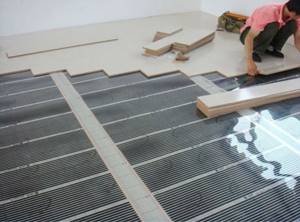
For this reason, an additional layer of film protection should be placed under thin coatings. Another characteristic is that the IR heater may overheat if large furniture or heavy household appliances are placed on it. Therefore, it is advisable not to lay canvases under such objects, leaving the space under large objects empty.
Ceiling placement PLEN
Film heaters placed on the ceiling are more popular. They function as follows: when the system is turned on, the emitters begin to propagate IR waves, directing them straight down. The rays rush to the floor, and most of them are absorbed by it. The remaining waves are absorbed by furnishings, as a result of which the floor and large furniture begin to collect heat and then release energy into the space.
According to the laws of physics, warm air mass rises to the top. Colder air currents descend and warm up. Therefore, the maximum temperature level in the room will be near the floor. At a height of 1.5-1.8 m its level will already be 1-2C lower. Doctors find this placement of temperature regimes most suitable for the body and excellent well-being of a person.
It should be remembered that heating occurs extremely uniformly. Another advantage: to hide PLEN infrared heating on the ceiling, you can use almost any available coating. The only exceptions would be suspended ceilings, both fabric and film, since it can be deformed from proximity to the heater.
However, if you really need to combine the suspended ceiling and PLEN, you can arrange an additional protective layer of plasterboard between them. Another advantage of installing film heaters on the ceiling area is the low risk of accidental damage.
Although, in an apartment building there is always a risk of leakage from neighbors above, as a result of which the system will inevitably fail. The disadvantages of ceiling placement include the complexity of installation. However, from a technical point of view, such a system is no different from a floor or wall installation method. Another flaw is the effect of IR radiation on household appliances.

The amount of energy required to heat an object is determined by its height. Professionals do not recommend installing a film system on the ceiling of a building with a height of more than 3.5 m, since in this case the costs of heating the home will be prohibitively high.
Cost of heating equipment PLEN – where to buy, prices, catalogs, manufacturers
| Manufacturer/Name | Radiation power, W/m2. | Price, rub./sq.m. | Notes |
| "Luch"/PLEN | 120-150 | 1200-1400 | Typical design: resistor, aluminum, Mylar film. |
| "PSO"/Zebra EVO-300 | 220-225 | 1250-1440 | Sections with dimensions of 0.5 x 0.6 m. It is permissible to connect elements to form a field of the desired configuration |
| "ESB-Technologies"/PLEN | 150 and 175 depending on modification | 1150-1300 | The manufacturer offers several options with protection according to IP classes: 44, 54 and 67. |
When choosing PLEN heating, technical characteristics, purchase price, cost of additional equipment and installation are considered as a whole. This approach minimizes errors. Use the comments to the article to obtain additional information, experience, and your own reviews of products from different manufacturers.
Structure and installation nuances
You can install this heating system yourself, but it is better to contact a specialist electrician. At a power of 5 kW, a single-phase input is recommended, and at higher powers, a three-phase input.
Under no circumstances should you mechanically or chemically influence the PLEN, change its dimensions or disassemble it!

Examples of sizes and characteristics of manufactured PLEN.
During installation, it is necessary to correctly direct the radiant energy. Plastic plugs will help secure each strip of heating film. These fastenings must be made carefully so as not to damage the film heater strips.
How Plan works
The operating principle is based on infrared radiation - when connected to an energy source and heated, the elements inside the film begin to emit heat waves. The temperature is absorbed by all objects, which, when heated, in turn give off heat to the next. Actually, any infrared heater follows this technology, so the principle of operation is simple and clear.

Warm floor based on PLEN
Warm floors are another type of economical heating option that is installed under the floor covering. This film floor heating system has many advantages:

PLeN element for floor
- Resistance to mechanical damage.
- Heat energy savings
- Maintains a certain level of humidity (does not dry out the air)
- Silent operation
- Immunity to power failures
- Favorable effect on health (warm floors based on PLEN are recommended to be installed in hospitals and schools, as they promote rapid tissue healing and normalization of pressure).
You can easily install a warm floor heating system with your own hands. However, there are several precautions for self-installation that you should consider when installing PLEN:

Heated floor installation
- Do not use aluminum foil to reflect heat. Use only materials recommended by the supplier.
- Do not lay PLEN under tiles.
- Do not use system components (clamps, tips) from other manufacturers; use only specially designed tools.
- Before installing the floor covering, test the installed PLEN system.
- Consider room humidity (install waterproofing if necessary).
In general, installing infrared (PLEN) heating with your own hands is a simple process, since it does not require special skills or appropriate education.
Minuses
Although there are not many of them, it is still worth considering the main disadvantages of infrared heating before installing it.
- A PLEN heater that is mounted on the ceiling does not always fit into the interior of the home, although there are various designs of such devices that may suit your environment.
- To install such a system in office premises, you will need official permission from the fire department, the procedure for obtaining which will take a lot of time and money.
- High installation price (but remember that it will pay off later).
- When installing an infrared heating system throughout the house, you are unlikely to save much, although such a solution will still cost less than any other type of heating.

